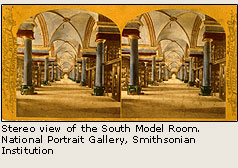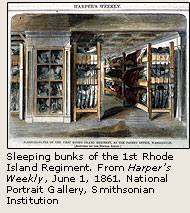|
|
 he
Old Patent Office Building, now a part of the Smithsonian
Institution, was the first federal exhibition hall in the
nation’s capital. During the Civil War, the building served
as a hospital for wounded Union soldiers, a temporary barracks,
and a morgue. In March 1865, it was the site of Abraham Lincoln’s
second inaugural ball. Poet Walt Whitman used to visit the
building to attend to the wounded. Praised by him as “the
noblest of Washington buildings,” this National Historic
Landmark was begun in 1836 and completed in 1868. It was the
fourth major federal building constructed in Washington. The
Patent Office was saved from the wrecking ball in 1958, and
Congress gave it to the Smithsonian in 1962. After extensive
interior renovation, the National Portrait Gallery and the
Smithsonian American Art Museum opened to the public in 1968. he
Old Patent Office Building, now a part of the Smithsonian
Institution, was the first federal exhibition hall in the
nation’s capital. During the Civil War, the building served
as a hospital for wounded Union soldiers, a temporary barracks,
and a morgue. In March 1865, it was the site of Abraham Lincoln’s
second inaugural ball. Poet Walt Whitman used to visit the
building to attend to the wounded. Praised by him as “the
noblest of Washington buildings,” this National Historic
Landmark was begun in 1836 and completed in 1868. It was the
fourth major federal building constructed in Washington. The
Patent Office was saved from the wrecking ball in 1958, and
Congress gave it to the Smithsonian in 1962. After extensive
interior renovation, the National Portrait Gallery and the
Smithsonian American Art Museum opened to the public in 1968.
The neoclassical-style Patent Office Building
was intended as “a temple to the industrial arts,”
reflecting the new nation's desire for advancement. It was
designed to display the models that inventors submitted with
their patent applications and also provided space for exhibits
of public interest beyond patent models. Such artifacts as
the Declaration of Independence, the tent George Washington
used in the Revolutionary War, and specimens from explorer
Charles Wilkes’s expeditions between 1838 and 1842 were displayed
here, as were the holdings of the National Institute—a
forerunner of the Smithsonian Institution—which included
artworks that formed the foundations of the collections of
the National Portrait Gallery and the Smithsonian American
Art Museum.
|



See more
For the Civil War diary of a U.S. Patent Office examiner, see Washington During the Civil War: The Diary of Horatio Nelson Taft, 1861-1865
|